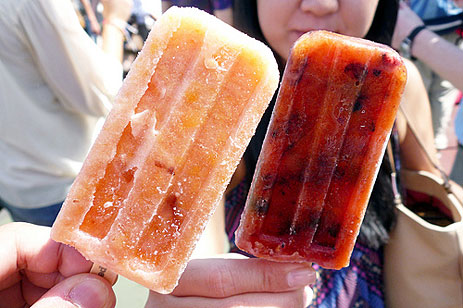With the economy in full recession, yet the good-food movement swelling in size — spurred in part by mass recalls of salmonella-tainted cheap eggs and listeria-contaminated sandwiches — mobile eateries cooking up tasty, mid-priced meals from fresh, local ingredients are gaining speed. Emily Gertz recently reported on this trend for Grist’s Feeding the City series; here’s a closer look at three of these sustainably minded and social-media-savvy small businesses.
Are there food trucks like these roaming your city? Give them a shout-out in the comments!
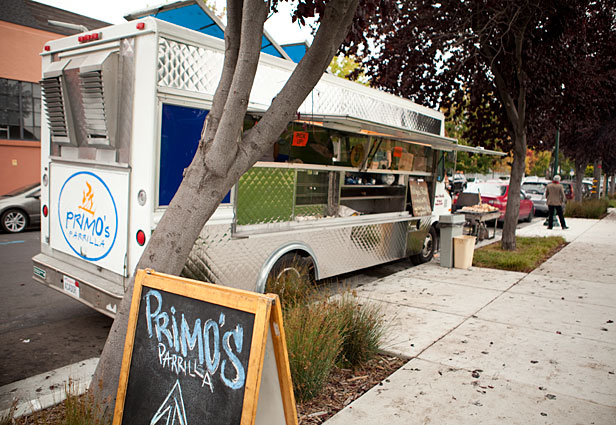 Curb appeal: Primo’s Parilla setting up for the lunch crowd in Emeryville, Calif.(Bart Nagel Photography)
Curb appeal: Primo’s Parilla setting up for the lunch crowd in Emeryville, Calif.(Bart Nagel Photography)
Primo’s Parilla: Grillin’ in E’ville
Emeryville, Oakland, and Berkeley, Calif.
Twitter VamosPrimos
What it is Food truck specializing in grass-fed beef, grilled Argentinian-style (parilla means grill)
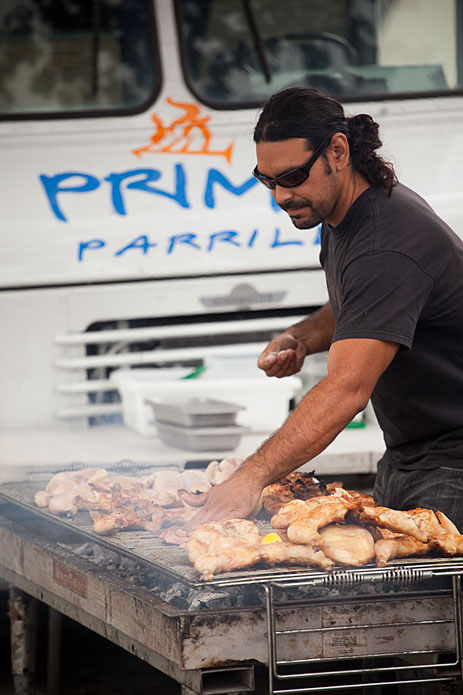 Primo time: Javier Sandes working on orders.(Bart Nagel Photography)Just minutes across the Bay Bridge from San Francisco, the 1.9-square-mile city of Emeryville, Calif., tucked between Oakland and Berkeley, is the most business-friendly of the four — home to Pixar’s headquarters, a Novartis campus, and a huge Ikea. It’s also turned into a magnet for the several of the Bay Area’s finest nouvelle food trucks.
Primo time: Javier Sandes working on orders.(Bart Nagel Photography)Just minutes across the Bay Bridge from San Francisco, the 1.9-square-mile city of Emeryville, Calif., tucked between Oakland and Berkeley, is the most business-friendly of the four — home to Pixar’s headquarters, a Novartis campus, and a huge Ikea. It’s also turned into a magnet for the several of the Bay Area’s finest nouvelle food trucks.
Argentina native Javier Sandes was able to get the permits for his new Primo’s Parilla food truck cleared at Emeryville’s City Hall in a matter of hours. Not long after, four months ago, he and his three partners pulled up their colorful truck next to a neighborhood park and fired up the grill. On it he slapped some grass-fed tri-tip from Tallgrass Beef, the grass-finished beef ranch in Kansas founded by broadcast journalist Bill Kurtis.
Huh? Kansas beef for the Bay Area’s notoriously finicky locavores?
“We wanted to use local beef,” Sandes tells me in between flipping some chickens (Mary’s Chicken, from California), “but no one could supply us with enough tri-tip.”
There was no question for him that the beef had to be grass-fed and -finished, as it is in Argentina. “For a while I stopped eating meat here because it just didn’t taste the same,” he says of U.S. grain-fed, fatty beef.
Tri-tip is a small, triangular muscle cut from the bottom sirloin — the bit in front of where the cow’s rear legs join the abdomen. It’s the cut traditionally used in Argentian asado (grilled meats), and unfortunately there is only one of the 2- to 3-pound roasts per steer. Very few of the Bay Area’s small pasture-based ranchers slaughter more than a steer per week. Sandes goes through 10-15 tri-tips in a single day.
Enter Tallgrass, which ships its meat, and then later, when Tallgrass ran into some supply problems itself, Estancia Grass-fed Beef, which pulls from ranches in the U.S., Uruguay, and Argentina.
However, a few customers have complained on Yelp that the beef was tough — meat from the muscles of pastured cows moving around eating grass does tend to be chewier than that from feedlot cows gorging on grain. And trying to saw through it with a compostable knife doesn’t help. “It’s hard to make everybody happy,” says Sandes, with a shrug that could be a wince. But when two plates were returned in one day recently, he panicked. Primo’s is now experimenting with grilling more tender (and plentifully available) rib-eye steaks from Estancia.
Grass-fed beef and organic chicken wholesale costs being what they are, Primo’s has had to price its lunch menu on the high side: $12 for a generous serving of beef, whether tri-tip or rib-eye, accompanied by its homemade piquant chimichurri sauce, organic spinach-and-sweet-potato-mash, and organic green salad. The chicken plate is $10, and handmade empanadas are $2 a la carte.
In the beginning a few people balked at the price. “People are used to going to a taco truck and getting a burrito for $5,” Sandes says. “We’re trying to change the mentality that just because it’s coming from a truck it’s not good quality and has to be cheap.”
Judging from the fact that the beef is often sold out by 1 pm, that change is well under way.
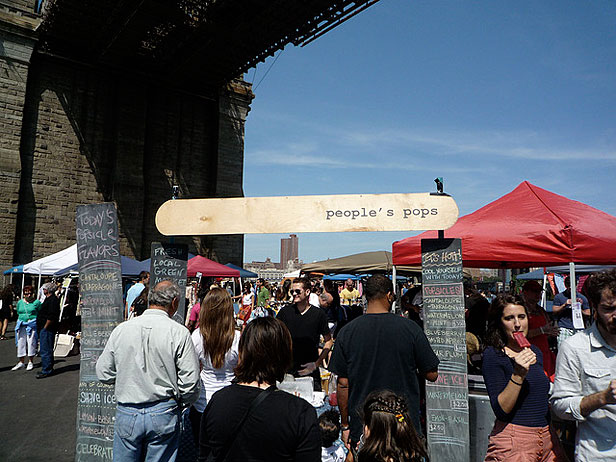 Stick it to me: People’s Pops at the Brookly Flea, Dumbo.(Photo courtesy of Emma.Marie via Flickr)
Stick it to me: People’s Pops at the Brookly Flea, Dumbo.(Photo courtesy of Emma.Marie via Flickr)
People’s Pops: Chillin’ in Manhattan
Manhattan and Brooklyn, N.Y.
Twitter: People’s Pops
Menu Frozen pops and shaved ice made with locally made fruit
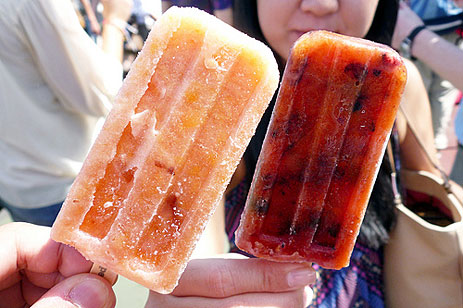 Tart pops: A Roasted Peach Ice and a Blueberry + Apricot Ice People’s Pop.(Photo courtesy of icherry via Flickr)People’s Pops came to life in May 2008, from a whim that popped out of the febrile brain of food/travel writer and cook Nathalie Jordi in response to a friend’s invitation to participate in an event for the then-nascent New Amsterdam Market. (The original name was The People’s Popsicle, until a cease-and-desist letter from Unilever showed up in April 2010.)
Tart pops: A Roasted Peach Ice and a Blueberry + Apricot Ice People’s Pop.(Photo courtesy of icherry via Flickr)People’s Pops came to life in May 2008, from a whim that popped out of the febrile brain of food/travel writer and cook Nathalie Jordi in response to a friend’s invitation to participate in an event for the then-nascent New Amsterdam Market. (The original name was The People’s Popsicle, until a cease-and-desist letter from Unilever showed up in April 2010.)
Ice pops seemed easy. “Who doesn’t love these refreshing little nuggets of fruit and sugar and ice, crystallized summertime? I even like the crappy ones,” she blogged. “We can do better, I think. Industrially produced ice pops are little more than water laced with high fructose corn syrup, juice from concentrate, gums and stabilizers. What about pops made just with locally, sustainably grown fruit and herbs, organic sugar, and a low proportion of water?”
Thus a monster was born. A monster with luscious flavors like Watermelon Lemongrass and Apricot Lavender, frozen from the freshest local fruits and berries.
From a table and a freezer at that New Amsterdam market opening, People’s Pops has grown to a stand at Brooklyn Flea, retail sales at two Manhattan Whole Foods and Brooklyn shops, and even its own summertime retail shop at Chelsea Market’s arcade.
Yet Jordi & her co-conspirators David Carrell and Joel Horowitz sell just seven months of the year. Why not capitalize on the dem
and with, say, a rosemary-butternut-squash pop?
“We could,” says Jordi diplomatically, from an airport on her way to Ecuador. (This woman travels more than Al Gore.) “We’re going to go to mid-October, we made a pumpkin-pie pop toward the end of last season. And there are pears and apples. But seriously, who wants to buy a popsicle in January, much less make one?”
Not her. The three use their time off to analyze how to grow better, and to recharge their batteries. Jordi’s now in business school at Tulane University in New Orleans, trying to figure out how to generate a bit more profit. “I made more money as a waitress,” she laughs. “But there’s something deeply satisfying about what we do, from dealing with the produce and farmers, to managing really cool people, to being part of a really interesting creative sustainable-food community. We still have fun.”
The original idea for the business may have been spur of the moment, but Jordi says she’s carried the inspiration for it a while. Her background is in artisanal food — cheese making — “but it’s always bothered me that that food is only accessible to people who make it a priority to spend their money on it. I’ve always lamented the lack of B-level food — food made with integrity out of quality ingredients. There’s a lot of room and demand for quality fast food.”
A People’s Pop is $3.50 — “several times over what it costs to buy a shitty pop, so I’m not flattering myself,” Jordi admits cheerfully. Still, that’s just the cost of a Starbuck’s latté. She’d like to bring the cost down by mechanizing the pops’ production instead of hand-stamping every one. But that requires funds to invest in machinery.
“Popsicles can be high quality and mass produced. You can’t say that about very many artisan foods,” she adds. “We want to bridge the gap between the 99 percent mass-produced shlock and the precious artisanal stuff.”
 Star dogs: Let’s Be Frank on the Paramount lot in Hollywood.(Let’s Be Frank)
Star dogs: Let’s Be Frank on the Paramount lot in Hollywood.(Let’s Be Frank)
By Emily Gertz
Let’s Be Frank: Who let these dogs out?
San Francisco and Los Angeles
Twitter: Let’s Be Frank SF
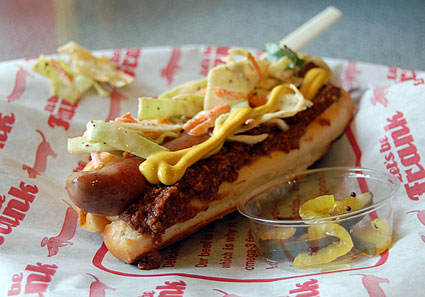 Dog gone wild: Let’s Be Frank chili dog with some of John Scharffenberg’s sauerkraut.(Photo courtesy of stu_spivak via Flickr)Menu 100 percent grass-fed, hormone-nitrite-nitrate-free beef hot dogs, as well as bratwurst and Italian-style sausage made from naturally raised pork
Dog gone wild: Let’s Be Frank chili dog with some of John Scharffenberg’s sauerkraut.(Photo courtesy of stu_spivak via Flickr)Menu 100 percent grass-fed, hormone-nitrite-nitrate-free beef hot dogs, as well as bratwurst and Italian-style sausage made from naturally raised pork
Sue Moore and Larry Bain co-founded the business in 2005, intending to change “the world, one hot dog at a time.” Moore was formerly a “meat forager” who sourced the best non-adulterated, humanely-raised meats she could find for locavore-groundbreaking restaurant Chez Panisse. Bain was a restaurant professional with 30 years’ experience, including managing the ritzy French restaurant Jardiniere, and active in promoting sustainable foods in San Francisco. From a single San Francisco hot dog cart, LBF has grown to 10 employees and two regular carts in the city along with a sit-down location, a truck in Los Angeles, catering events, and selling its custom-made hot dogs in retail markets.
Bain and Moore have combined their business and sourcing acumen with a vision for making sustainable eating not just delicious but affordable. “My day job was running these high end restaurants,” says Bain. “But I had a non-profit that was focused on hunger issues in underserved communities, and how to get good food into these places that are food deserts.” Doing this work, he said, he encountered children “who were having the diseases 80-year-olds are having – [that is] 80-year-olds who really indulged,” such as obesity and diabetes.
Running a hot dog business helps get healthy foods into the hands – and mouths – of children. (Bain says some of Frank’s best customers are moms.) But not at the expense of taste: “Every minute of my 30 years in the restaurant business has been needed to be sure our hot dogs are delicious,” he says. Frank also helps grass ranchers stay in business, by paying well for hundreds of pounds of non-prime cuts of beef that would otherwise end up on the bottom-dollar commodity market.
Bain has pragmatic advice for aspirants to the nouvelle street-food scene: First identify a promising location, and determine what would be necessary to start operating there in terms of licensing, zoning laws, and other bureaucratic requirements.
“If you want a sustainable business,” he says, “you don’t want to be running away from the police all the time.”

